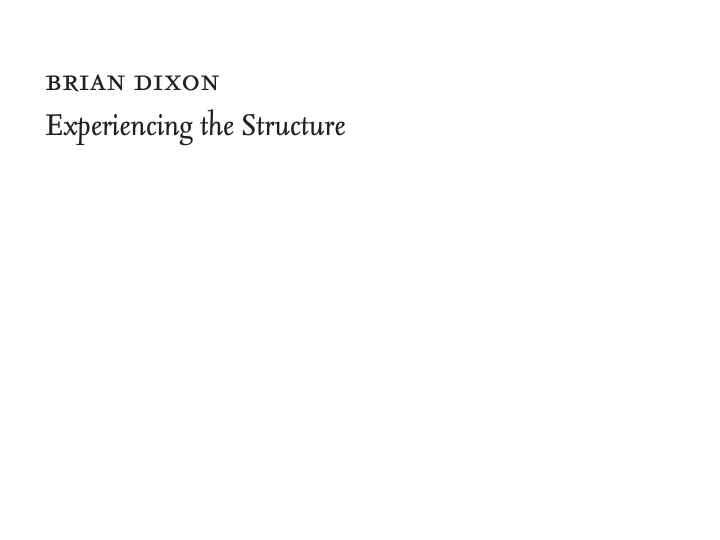



brian dixon Experiencing the Structure
this talk Visual communications theory. Research through design. A case . Ontology. A framework. Thinking further.
this talk Envisaging a native mode of knowledge production for visual communications.
interest in the visual Art and design history, visual anthropology, visual sociology, visual culture, information visualisation, and cognitive psychology.
the theoretical landscape
the theoretical landscape Fragmented epistemologies...
the theoretical landscape ‘Visual intelligence/Cognition/Perception Visual literacy Graphic Design/Aesthetics Visualisation/Creativity Visual culture/Visual rhetoric/Visual semiotics Professional performance: Photography/Film/ Video/Internet/Mass media/Advertising/PR’ (Moriarty and Barbitsis 2004:10)
the theoretical landscape ‘Who… Says What… To Whom… In Which Channel…’ (Fahmy, Bock and Wanta 2014:vii)
research through design
bang et al.’s (2012) model of research through design Motivation Knowledge Experiments Evaluation Hypothesis Research Questions
a case
a case Motivation Literature Semi- Review Structured Interviews Knowledge Experiments Evaluation Hypothesis Research Questions
a case Investigating how a mobile map could be designed to allow a walker to remain aware of their surrounding environment in use.
A Contextualised Graphic Syntax for the Design of a GPS-Enabled Wayfinding Interface to Visually Support an Urban Recreational Walker’s/Wanderer’s Situation Awareness in Use The interface was designed to visually support an intrinsically motivated urban recreational walker’s/wanderer’s situation awareness in use, when walkers are from Britain and Ireland, and seeking to apply exploratory wayfinding practices. Its aims to: Orientate the walker with: Relate to the surrounding environment with: a distorted integral metric space a static labelled node displaying responsively rotating labelled nodes responsively rotating labelled nodes the user’s location representing the direction representing the direction and order of landmarks of urban districts Offer a limited amount of content and interactivity: when compared to conventional GPS-enabled wayfinding interfaces Through the above, the walker/wanderer may perceive a direction-based and clear/simple design, with features that enrich their experience and/or provide a grounding/reassurance. Further, they may identify a link between the information presented on screen and that which it represents. In terms of meanings, walkers/wanderers have been seen to commonly identify such an interface as being for use in immersive situations, e.g. touring, exploration or wandering.
Orientate the walker with: Relate to the surrounding environment with: a distorted integral metric space a static labelled node displaying responsively rotating labelled nodes responsively rotating labelled nodes the user’s location representing the direction representing the direction and order of landmarks of urban districts Offer a limited amount of content and interactivity: when compared to conventional
a designer’s ontology
a designer’s ontology An ontological position is often implicitly linked to an epistemological position (Crotty 1998:10).
a designer’s ontology Objectivists claim that ‘social phenomena confront us as external facts’ (Bryman 2008:33).
a designer’s ontology For constructionists, the world is constituted in our experience and, so, is in a constant state of revision (e.g. Lincoln and Guba 1985).
a designer’s ontology Where we locate the reality of our design outcomes?
a designer’s ontology Generalisability. Transferablity.
expanding information design theory Yuri Engelhardt’s The Language of Graphics (2002) provides a framework which can be universally applied in the analysis of graphic representations.
thinking further
thinking further How particular typographic arrangements are experienced by particular participant groups.
thinking further Further adaption could allow for a description of the more exacting structural details of typefaces and, again, set these beside participants’ experiences of that work.
thinking further A knowledge base that designers own.
Recommend
More recommend